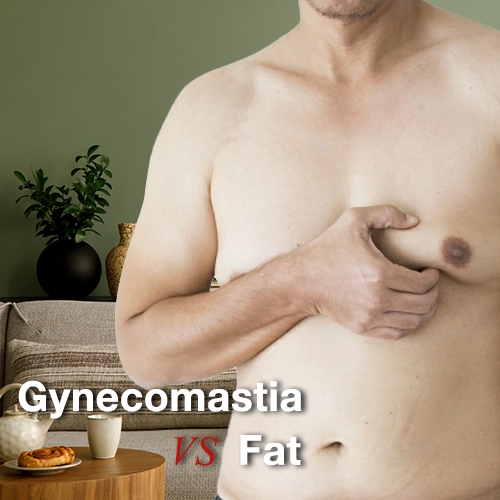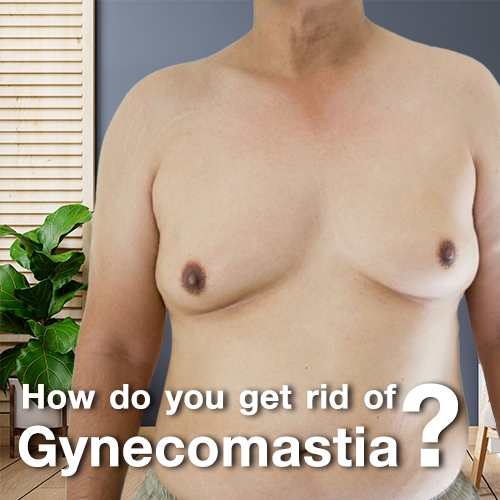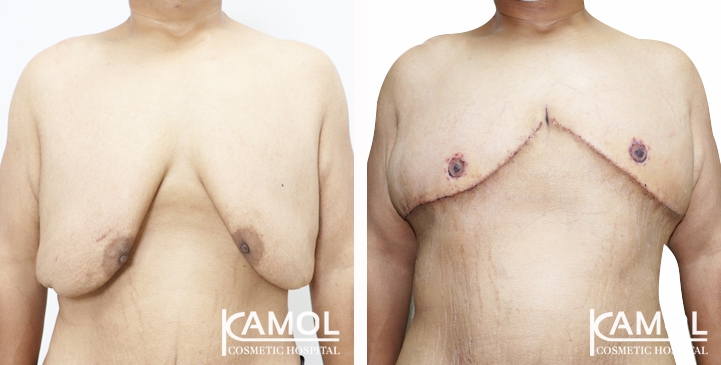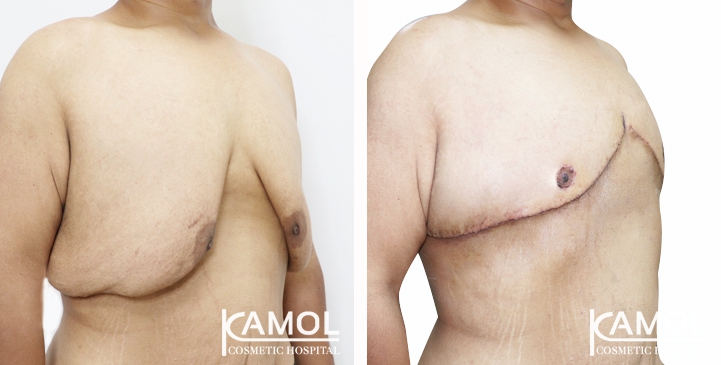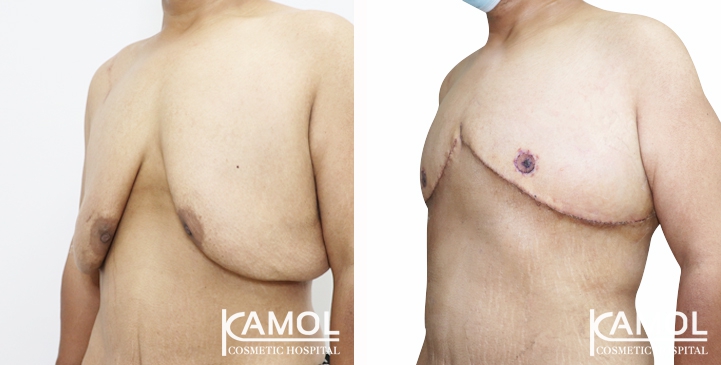What is Gynecomastia?
Gynecomastia is a medical condition that affects the breast tissue of men, resulting in the enlargement of breast tissue. This condition can be caused by a variety of factors, including hormonal imbalances, certain medications, and obesity.
One of the most common causes of gynecomastia is an imbalance of hormones in the body. The breast tissue of men is sensitive to changes in hormone levels, and an increase in estrogen or a decrease in testosterone can cause the breast tissue to enlarge. This is particularly common during puberty, when hormone levels are fluctuating.
Certain medications can also cause gynecomastia. Some medications used to treat prostate cancer, for example, can lead to the development of breast tissue in men. Additionally, some antidepressants and antibiotics have been linked to the condition.
Obesity can also be a contributing factor to gynecomastia. Men who are overweight may have an increased amount of breast tissue due to the presence of excess fat in the body. This is because fat cells can convert androgen into estrogen, leading to an imbalance in hormone levels.
Who is a good candidate for Gynecomastia surgical procedure?
A good candidate for gynecomastia surgical procedure is typically a man who:
- Has developed breast tissue due to hormonal imbalances, certain medications, or obesity, and is experiencing discomfort or embarrassment as a result.
- Has been diagnosed with gynecomastia by a medical professional and has no underlying medical conditions that would contraindicate surgery.
- Has realistic expectations for the outcome of the surgery and understands the potential risks and benefits of the procedure.
- Is in good physical health, does not smoke and is at a stable weight.
- Has completed puberty as the condition can be temporary in some cases, it is important to wait till breast development is finished.
- Understands that the surgery will leave scars, although they can be hidden in most cases.
What are the steps to follow before Gynecomastia operation?
The pre-operative routine for gynecomastia surgery typically includes the following steps:
- Initial Consultation: The first step is to schedule a consultation with a board-certified plastic surgeon who has experience with gynecomastia surgery. During this consultation, the surgeon will examine your breast tissue and discuss your goals for the surgery. They will also review your medical history and perform any necessary tests to ensure that you are a good candidate for surgery.
- Laboratory Tests: Your surgeon may require you to have blood tests, EKG or chest X-ray, and other tests to ensure that you are in good health and ready for surgery.
- Stop smoking: If you are a smoker, your surgeon will likely advise you to stop smoking for at least 4-6 weeks before and after the surgery to reduce the risk of complications.
- Medications and Supplements: You will be advised to stop taking certain medications, such as blood thinners, several weeks before the surgery. You should also inform your surgeon of any supplements or herbal remedies you are taking.
- Pre-operative Instructions: Your surgeon will provide you with detailed instructions on what to do before the surgery. This may include instructions on when to stop eating and drinking before the surgery, as well as what to wear on the day of the surgery.
- Pre-operative meeting with anesthesiologist: You will meet with the anesthesiologist before the surgery to discuss the type of anesthesia that will be used during the procedure.
It's important to follow your surgeon's instructions carefully and to attend all scheduled appointments leading up to the surgery. This will help to ensure that the surgery goes smoothly and that you have the best possible outcome.
Gynecomastia post operative care:
The post-operative care for gynecomastia surgery is an important aspect of the recovery process. It is important to follow your surgeon's instructions to ensure that the surgery goes smoothly and that you achieve the best possible outcome. Typically, the post-operative care for gynecomastia surgery includes the following steps:
- Pain management: You may experience pain and discomfort in the breast area for several days after the surgery. Your surgeon will provide you with pain medication to help manage the pain.
- Swelling and Bruising: It is normal to have swelling and bruising in the breast area after the surgery. This should start to improve within a few days and will continue to improve over the next few weeks.
- Wearing a Compression garment: Your surgeon may recommend that you wear a compression garment to help reduce swelling and to support the healing process. You will need to wear this garment for several weeks after the surgery.
- Rest and Recovery: You will need to take it easy for the first few days after the surgery. Avoid strenuous activities and heavy lifting for at least the first week after surgery.
- Follow-up Appointments: You will need to attend follow-up appointments with your surgeon to monitor your recovery and check on the healing process. Your surgeon may also give you additional instructions on how to care for yourself after the surgery.
- Avoid smoking and alcohol: Your surgeon will advise you to avoid smoking and drinking alcohol, as they can slow down the healing process.
- Incision Care: You will need to take care of the incision area, keeping it clean, and dry. You will have to avoid showering for the first 24-48 hours and use only mild soap when you do shower.
It is important to keep in mind that recovery time can vary from person to person. It will take time for the swelling and bruising to subside, but with proper care and following your surgeon's instructions, you should be able to return to normal activities within a few weeks.
Possible risks and complications for Gynecomastia:
As with any surgical procedure, there are risks and complications associated with gynecomastia surgery. Some of the possible risks and complications include:
- Infection: An infection can occur at the surgical site and may require additional treatment.
- Hematoma or Seroma: Hematoma is a collection of blood outside the blood vessels and seroma is a collection of fluid. These can happen after surgery and may require additional treatment.
- Scarring: All surgeries leave scars, and the same goes for gynecomastia surgery. However, most scars can be hidden in the underarm or around the areola.
- Numbness or Tingling: There is a possibility that the nerves in the breast area may be damaged during the surgery, which can lead to numbness or tingling.
- Asymmetry: In some cases, the breast tissue may not be removed evenly, resulting in asymmetry between the two breasts.
- Changes in Sensitivity: Some men may experience changes in sensitivity in the breast area after surgery.
- Recurrence: in some cases, the breast tissue may return or grow again after surgery, this is rare but can happen if the cause of the gynecomastia was not addressed, such as hormonal imbalances.
- Unsatisfied results: In some cases, the patient may not be satisfied with the results of the surgery, which may require revision surgery.
It's important to keep in mind that most of these complications are rare and can be avoided by following your surgeon's instructions, and choosing a qualified and experienced surgeon. It's also important to have realistic expectations and understand that the outcome of the surgery may not be perfect. Your surgeon will be able to provide you with more detailed information on the risks and complications of the surgery during your consultation.
Getting to Know for Gynecomastia
Gynecomastia vs Fat
Gynecomastia vs Fat
How do you get rid of gynecomastia?
How do you get rid of gynecomastia?
What happen if gynecomastia is not treated
What happen if gynecomastia is not treated
Before & After Gynecomastia
What are the different surgical techniques offered at Kamol Cosmetic Hospital for treating gynecomastia?
Kamol Cosmetic Hospital offer a variety of techniques for treating gynecomastia. Here are a few of the techniques that are used at Kamol Cosmetic Hospital:
- Liposuction: This is a common technique used to remove excess fat from the breast area. The surgeon will make small incisions in the breast area and use a thin tube called a cannula to suction out the excess fat.
- Excision: This technique involves making an incision in the breast area and removing excess breast tissue and/or skin. This technique may be used in cases where there is a significant amount of excess breast tissue.
- Ultrasonic Liposuction: This technique is similar to traditional liposuction, but it uses ultrasonic energy to break up and remove the fat before suctioning it out. This technique can be used to remove large volumes of fat and is often used in cases of severe gynecomastia.
- Vaser Liposuction: This is similar to ultrasonic liposuction, but it uses a different type of energy, called Vaser energy, to break up the fat before suctioning it out. This technique can be used to remove large volumes of fat and is often used in cases of severe gynecomastia.
- Combo surgery: This technique combines liposuction and excision to remove both the fat and the glandular tissue. This technique is used in cases where there is a combination of excess fat and glandular tissue.
Note that the technique that is best for you will depend on your individual case and the surgeon will recommend the best technique for your case after examination and consultation.


